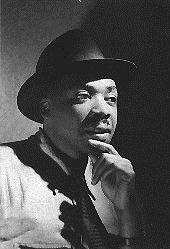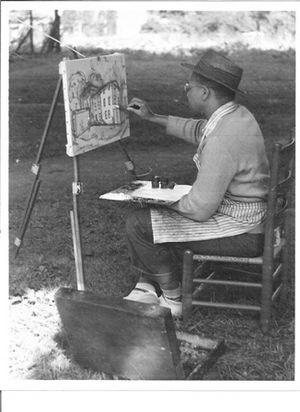Claude Clark facts for kids
Claude Clark (November 11, 1915 – April 21, 2001) was an American painter, printmaker, and art teacher. He was known for his art that showed the experiences of African American culture. His paintings often featured dance scenes, kids on the street, ocean life, and landscapes. He also created art about religion and politics. Claude Clark mostly used a palette knife to create his artwork.
Contents
A Young Artist's Journey
Claude Clark was born on a farm in Rockingham, Georgia in 1915. When he was about eight years old, his family moved to Philadelphia, Pennsylvania. They were part of the Great Migration, when many African Americans moved from the South to find better lives.
In high school, Claude discovered he was good at painting. His Sunday School teacher encouraged him to show his art. After high school, he studied at the Philadelphia Museum School of Industrial Art. He also got a special scholarship to study at the Barnes Foundation in 1939.
In 1943, Claude married Effie May Lockhart. They worked together in art, education, and life. During the Great Depression, Claude worked for the Works Progress Administration (WPA). This was a government program that helped artists find jobs. He worked in a graphics art shop, creating prints.
Claude Clark also wrote a book called A Black Art Perspective. It was a guide for teachers on how to teach about Black visual arts. He helped create the first African American Studies curriculum. He also helped many young artists and scholars.
Learning and Growing as an Artist
Claude Clark went to Roxborough High School in Philadelphia. From 1935 to 1939, he studied art at the Philadelphia Museum School of Industrial Art on a full scholarship. There, he discovered the work of Van Gogh. Van Gogh's style, with its thick paint and loose brushstrokes, greatly influenced Claude's own art. Claude learned to apply paint thickly using a palette knife.
In 1939, Claude was accepted into the Barnes Foundation. He studied there until 1944. The Barnes Foundation had an amazing collection of art, including African art, European Impressionism, and American art. This allowed Claude to study many famous artworks up close.
While studying, Claude also worked for the Federal Art Project of the WPA. He later moved his family to Talladega, Alabama, and then to Sacramento, California. He earned his Bachelor of Arts degree from California State University, Sacramento in 1958. He then earned his Master of Arts degree from the University of California, Berkeley in 1962.
A Dedicated Painter and Teacher
Claude Clark became a skilled artist by focusing on his talent. He didn't let challenges like racism or poverty stop him. When he couldn't afford new paint, he would find old paint cans in the trash. He mixed his own colors. He also couldn't afford brushes, so he became an expert at using a palette knife.
Claude started painting and showing his art at a young age. He sold his first artworks in his early twenties. His paintings are still sought after by collectors today. He taught art in Philadelphia public schools from 1945 to 1948.
He became very interested in African and African American history. This led him to teach at Talladega College in Alabama from 1948 to 1955. He continued to paint, teach, and research while supporting his family.
In 1955, Claude moved his family to California for more opportunities. He taught art classes at California State University, Sacramento while earning his own degree. After graduating in 1958, he taught art in Alameda County, California. He later became an art instructor at Merritt College from 1968 to 1981.
In 1967, Claude helped organize the first national African American art exhibition. It was held at the Oakland Museum of California.
Claude continued to paint, research, and exhibit his art throughout his life. He worked from his studio in Oakland, California, after retiring from teaching in 1981. His art has been shown in many countries, including the United States, Africa, the Caribbean, Europe, and South America.
Claude Clark passed away in Oakland, California, in 2001 after a long illness. His work has been featured in important exhibitions, such as Two Centuries of Black American Art in 1985 and We Speak: Black Artists in Philadelphia, 1920s-1970s in 2015.
Where You Can See His Art
Claude Clark's artwork can be found in many public collections. These include:
- Howard University
- Metropolitan Museum of Art
- National Afro-American Museum and Cultural Center
- Philadelphia Museum of Art
- Smithsonian American Art Museum
- de Young Museum
Awards and Honors
- Silver Medal, St. Nicholas League, 1933
- Barnes Foundation Fellowship, 1942
- Carnegie Fellowship, 1950
See also
- African-American art
- List of Federal Art Project artists





